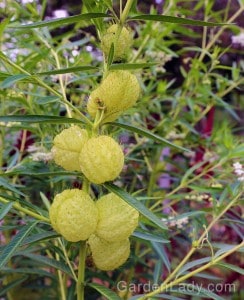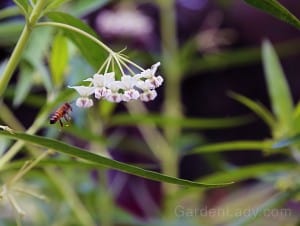Has anyone ever told you to “grow a pair?” Well…why stop at just two? When it comes to balls, you can grow several and they can be hairy! And at the same time, you’ll be growing great material for cut-flower bouquets, attracting pollinators to your gardens, and causing those who visit your flower or veggie beds to smile. Take it from me: the smiles alone are worth planting Gomphocarpus physocarpus.
In warm climates this is a tall perennial. In fact, in zones 8 through 10 it can self-seed and even become invasive. That’s not a concern in northern regions, however, and this is a fun plant to grow. Start the seeds indoors in March, using lights if necessary. Transplant outside into a sunny spot once all danger of frost is past. After that, water regularly, fertilize with the product of your choice and then stand back and enjoy the show.
The genus name of this tall plant comes from Greek and means club (gomphos) and fruit (karpos). The species is also Greek in origin, meaning bladder (physo) and fruit (karpos). The plant is related to milkweed and attracts bees and wasps making it a good choice for growing near the veggie garden. It is also called balloon plant and when picked green the inflated seed pods dry well.
So grow a pair (or more) or hairy balls this spring!

Yup…they are indeed hairy balls. In pairs.

I find the flowers as beautiful as the seed pods, and since the plants usually grow to 5 or 6 feet tall, you can look up into the blooms as the bees do.



Can a hairy ball tree be grown as a perennial in Kansas or is it an annual. Thank you.
This plant is an annual in Kansas, as it is for me. You’re better off to grow it from seed, starting the seeds in April for planting after last frost.
Do you pick the balls and dry out for seeds? I had a hairy ball plant come up wild?
I don’t harvest the seeds but let them fall on the ground. They self-seed very well from year to year so I never have to plant them now…I just have to recognize them and pull the weeds around them.
I take it these haven’t been ‘criminalized’ by the native plant advocates? I seem to recall there is another milkweed wanna-be that kills monarchs. Is it OK to let the monarch caterpillars eat the leaves of hairy balls? (Mine, here on Cape Cod, are suddenly covered with those big stripy caterpillars, which I assume to be monarch caterpillars.)
This plant is one of the few non-natives that support monarch larvae and do not harm them.
I have three hairy balls plants that did extremely well this Summer. I bought them from a local nursery. I know they’re annuals and should self seed, but do I need to cut down the stalks/stems now that it’s fall? I leave in Illinois. I want them to return next year. We had so many beautiful butterflies in our yard. Thank you!
Just be sure to watch for the seedlings next year and don’t weed them out. Don’t cover the soil with mulch as the seeds germinate better with sunlight.
I have one plant that I am attempting to overwinter and replant outside next year. Will this one plant produce seed next year or will it need a “partner” for pollen before it will produce seed. Thanks.
These don’t need others to pollinate. One plant should be fine.
I’ve read that one plant cannot produce fertile seeds alone, that you need more than one to get good seed.
Not all plants are like that – some are what is called “self-fruitful” and fertilize themselves very well with one plant. Tomatoes, for example!
hello my name is Alicia im from buffalo ny, i grew a hairy ball milkweed… it did great the monarchs LOVED IT. well it produced balls and i brought them inside due to the weather changing. how can i tell if the seeds are gonna be good to plant?
If the seeds mature so that the pods opened up, you can plant them.